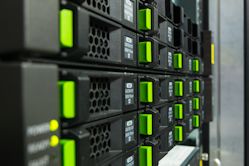How flash data solutions can boost your productivity
How flash data solutions can boost your productivity

New technologies, like flash data storage, can help you and your business by:
- Saving the time spent on everyday tasks and activities
- Limiting downtime of your website or file server
- Creating an efficient working environment
- Reducing everyday frustrations caused by slow network response times
- Giving your savings, investments or growth a boost.
Inefficient data storage is causing serious bottlenecks for businesses. Complex workflows, sprawling infrastructure and a growing demand for higher service levels are forcing companies to rethink their data strategy.
Individual business objectives can range from increasing efficiency or reducing costs to improving responsiveness; flash solutions stand out among the alternatives with their ability to meet any and every one of these requirements.
Although flash solutions were once considered as tactical measures for patching up individual application-level pain points, they have become increasingly popular alternatives for servicing entire data centres. With industry experts predicting that flash is here to stay, we wanted to take a moment to outline the ways that small businesses can benefit from deploying this technology.
Before diving deeper into the universal advantages of flash solutions, let’s take a closer look at the technology allowing the fast and reliable performance that has become synonymous with all-flash arrays.
All-flash arrays, or AFAs, are defined as enterprise storage arrays that contain several solid-state disks (SSD) to substitute the spinning hard drives of traditional hard disk drive (HDD) solutions. This type of non-volatile memory can be erased and reprogrammed in an instant – or "in a flash".
Faster, better, cheaper
Compared to conventional hard drive arrays, the ultimate benefit of flash technology is that it enables significantly faster data transfer rates, while improving the access to data and bringing down costs.
As SmartData Collective’s Rick Delgado has said: "Whereas hard drives usually take a while to fully boot up whatever machine they're attached to, flash storage can get equipment up and running in mere seconds. Flash storage can handle larger workloads much more quickly, making them excellent choices for working with complex data sets and operations."
Simplified infrastructure
When it comes to data storage and management, less really is more. With EMC’s XtremIO, businesses can also free up valuable space. Storage Switzerland’s George Crump said: “What formerly occupied eight fully configured cabinets in the data center now occupies a single 42U rack. This is translating into significant floor space and power savings." The savings in facilities and power costs alone are a significant improvement but that’s not all there is to it.
Reliability and simplicity are often among firms' highest data management priorities. Businesses are increasingly looking for solutions that don't require extensive expertise. Intuitive and user-friendly flash solutions help divert critical resources to other tasks, enabling companies to do more with less.
Always on
Immediate access to data and the ability to perform real-time analytics have become core business requirements. On the other hand, strict service level agreements and growing workloads are putting constant pressure on IT departments. All-flash solutions meet the varied demands of businesses with always-on services that enable the provisioning, de-duplication, compression and protection of data in real-time, with no application downtime.
However, the best part of all-flash data solutions is that they are agile, completely future-proof and can handle additional workflows as they occur. This means that new business activities and growth is met with ease, limiting the need for accurate predictions of future requirements.
Costs down, margins up
All-flash arrays' high I/O throughput and low latency can deliver significant savings in hardware costs. Furthermore, the reduced number of required CPU cores is reflected in lower software license expenses, further improving the economical efficiency of all-flash solutions.
Businesses can then use these savings to improve their pricing strategy, offering more competitive deals to customers or investing in long-term product improvement.
Sponsored post: copyright © 2016 Rob Bradburn, Senior Web Operations Manager, Digital Insights & Demand, EMC – EMEA Marketing




Comments
Add a comment